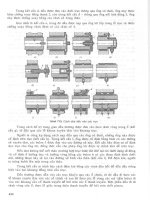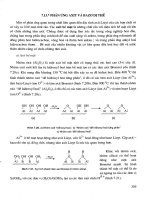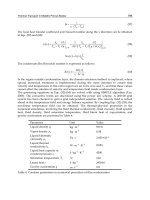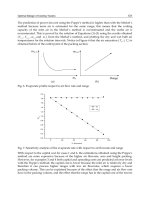Waste Management 2009 Part 8 pot
Bạn đang xem bản rút gọn của tài liệu. Xem và tải ngay bản đầy đủ của tài liệu tại đây (3.08 MB, 18 trang )
Solid Waste Management through the Application of Thermal Methods
119
CuKα radiation from 10 ≤ 2θ ≤ 70° at a scanning speed of 0.3°/min, using a Siemens D5000
powder X-ray diffraction unit, operating at 30 mA and 40 kV. The XRD analysis patterns are
shown in Fig. 18 and 19 for water quenched and air-cooled slag respectively.
Fig. 18. XRD of the water quenched slag
Fig. 19. XRD of the air-cooled slag
The XRD pattern (Fig. 18) indicates that the water quenched slag is composed of mainly
amorphous and traces of crystalline phase. Crystalline phases were identified by comparing
intensities and positions of Bragg peaks with those listed in the Joint Committee on Powder
Diffraction Standards (JCPDS) data files. The crystalline phases that could be identified were
cristobalite (SiO
2
), corundum (Al
2
O
3
), mayenite (Ca
12
Al
14
O
33
) and iron aluminum oxide
(Fe
1.006
Al
1.994
O
4
).
The XRD pattern of the air cooled slag revealed an amorphous phase and no crystalline
structures or phases are observed (Fig. 19). The formation of glassy amorphous structures
Waste Management
120
drastically reduces the specific surface area and present better resistance to the
decomposition by an acid than the crystalline structure.
The SEM micrographs in Fig. 20 illustrate the morphology of the two slag types. More
specifically, no significant differences were noted and the common conclusion is that both
water-cooled and air-cooled slags are characterized as equable.
Water-cooled slag (granules) Air-cooled slag
Fig. 20. SEM images
Consequently, the SEM images make us conclude that the slight crystalline areas present in
water quenched slag are enclaved and, therefore, both types of solid residues are considered
really stable and inert.
Solid Waste Management through the Application of Thermal Methods
121
On the basis of the primary results derived from the operation of the demonstration
gasification facility in Mykonos and elsewhere, plasma gasification is a promising
technology especially in the case of isolated areas, such as islands. More specifically,
• The method is characterized by relatively low air emissions that are not harmful for the
environment. The release of polluting substances, such as SO
2
, metals, dioxins will be at
much lower levels than conventional thermal techniques like incineration.
• Gasification can be used for the management of all types of waste, both hazardous and
non hazardous waste. Such facilities can handle municipal, toxic and hospital waste or
mixtures of them
• Plasma gasification is not an incineration process. As a result, the disadvantages of the
incineration are avoided.
• No ash or other by-products, such as biomass that has to be disposed at landfills after
the treatment. In this way, there is no disposal cost provided that there is market for the
vitrified slag.
• The material recovery is greater than in any other thermal technique. Instead of
consuming raw materials, this method produces slag that can be used as material in a
variety of applications, such as construction works.
• Energy recovery is higher than any other waste management practice. Therefore, the
income for energy sale can be significant. It is supported that in the case of plasma
gasification the generation of net electricity (steam turbine power generation) from 1
tone of municipal solid waste could reach the value of 816kWh. The relevant net
electricity from pyrolysis (Mitsui R21 Technology) is 571 kWh and 544 kWh from mass-
burn technology (Circeo 2007).
• The emissions at air, water and soil are lower than in other processes.
• Plasma gasification can be used for energy production from non gas fuels.
• The releases to the atmosphere during the production of electrical energy are similar
with those of facilities with natural gas.
• Since every C-based substance that exists in the plasma gasifier is converted to gas, each
of them can be used as fuel (Lemmens et al., 2007).
6. Conclusions
The energy utilization from waste can be achieved with the application of different thermal
technologies (anaerobic digestion, a biological waste management method, can also result in
energy recovery form waste). The basic operation principles that should apply to all thermal
treatment facilities for municipal solid waste are:
1. Steady operation conditions.
2. Easiness for adaptation to rough changes of the composition and the quantity of feedstuff.
3. Flexibility for adaptation to the variations of the composition and the quantity of the
used fuel.
4. Full control of the pollutants in the emissions.
5. Maximization of the utilization of the thermal energy, mainly for the production of
electrical energy.
6. Minimization of the capital and operation cost.
Summarizing the main characteristics of the common thermal techniques for waste
management, the following table presents the basic products and the main operation
conditions.
Waste Management
122
Parameter Incineration Pyrolysis Gasification
Operation conditions
Temperature
ο
C 800-1,450 250-700 500-1,600
Pressure (bar) 1 1 1-45
Atmosphere Air Inert/Nitrogen Gasification factor:
Ο
2
, Η
2
Ο
Stoichiometric
relation
>1 0 <1
Products
Gas Phase CO
2
, Η
2
Ο, O
2
, N
2
H
2
, CO, H
2
O, N
2
, H/C H
2
, CO, CO
2
, CH
4
,
H
2
O, N
2
Solid Phase Ash, Scoria Ash, Scoria Ash, Scoria
Liquid Phase Pyrolysis Oils & H
2
O
Table 4. Parameters of typical operation conditions & products of the common thermal
management practices
Thermal waste management methods should be applied together with separation at source
of all materials that can be recycled in order to maximize material recovery from waste. The
advantages of thermal methods in waste treatment are summarized as follows:
• Reduction of the weight and volume of the treated waste: The final solid residues have
weight that varies from 3 to 20% in relation to the initial weight of waste, depending on
the technology that is used. Gasification and pyrolysis result in lower quantities of solid
residues comparing to incineration.
• Absence of pathogenic factors in the products:
• The products of thermal treatment, due to the high temperatures that are
developed, are characterized from complete absence of pathogenic factors.
• Demand for limited areas:
• The thermal treatment units are characterized by low demands for land for their
installation.
• The pyrolysis and gasification processes require less space in relation to incineration.
• Utilization of the energy content of waste:
• Through the thermal treatment technologies, the exploitation of the energy content
of waste is possible.
• This energy can be either electric or thermal energy.
• Reduction of the burden paused to the landfill sites and consequent increase of their
lifetime.
• Extraction of the organic fraction of municipal waste from landfill sites, as required by
the relevant legislative framework (Directive 1999/31/EC).
Indicative disadvantages of the application of thermal methods are the following:
• Relatively high capital cost:
• Higher than that of other technologies for the management of municipal waste.
• Significant part of the total capital cost, especially for the case of incineration, is
spent on antipollution measures.
• Increased operation cost
Solid Waste Management through the Application of Thermal Methods
123
• In general, the thermal management techniques are characterized by relatively high
operation cost. The cost is reduced substantially as the capacity of the plant increases.
• Demand for high quantities of waste:
• Especially for the case of incineration – combustion, a minimum capacity is
required so that the units are financially feasible. Estimated minimum served
population from incineration facilities is 100,000 inhabitants (around 50,000 tones
of waste annually). Gasification and pyrolysis can be applied for much lower waste
quantities (around 15,000 tones of waste per year)
• Need for specialized personnel.
Regarding the first pilot application for waste gasification in Greece, an EU country where the
thermal management of municipal waste is not applied, the main advantages of the process
involve: good environmental performance, production of more than 500 KWh net of electricity
per tone of waste treated, no by-products going to landfill. Therefore, it is hoped that this
attempt will lead to full scale gasification facility in Mykonos, which will cater for the needs of
the whole island treating municipal as well as other waste streams (e.g. hospital waste), with
total capacity in the range between 10,000 and 15,000 tones per year. The fulfilment of the
whole project will constitute innovative achievement at European level and will be an effective
waste management success story for isolated areas and especially islands.
7. References
Allsopp, M., Costner, P. & Johnston, P. (2001). Incineration and human health, State of
knowledge of the impacts of waste incinerators on human health, ISBN: 90-73361-69,9,
Greenpeace Research Laboratories, University of Exeter, UK
Autret, E., Berthier, F., Luszezanec, A. & Nicolas, F. (2007). Incineration of municipal and
assimilated wastes in France: Assessment of latest energy and material recovery
performances, Journal of Hazardous Materials B139, 569-574
Belgiorno, V., De Feo, G., Rocca, C. D. & Napoli, R.M.A. (2003). Energy from gasification of
solid wastes, Waste Management 23, 1-15
Blahos, L. (2000). Plasma Physics, the Fourth State of Matter, Giolas Editions, 1–12
Calaminus, B. & Stahlberg, R. (1998). Continuous in-line gasification/ vitrification process
for thermal waste treatment: process technology and current status of projects,
Waste Management 18 (1998) 547-556
Carabin, P. & Holcroft, G. (2005). Plasma resource recovery technology converting waste to
energy and valuable products, in: Proceedings of the 13th Annual North American
Waste to Energy Conference, NAWTEC13, 71–79, Article number NAWTEC13-3155
Carabin, P., Palumbo, E. & Alexakis, T. (2004). Two-stage plasma gasification of waste, in:
Proceedings of the 23rd International Conference on Incineration and Thermal
Treatment Technologies, Phoenix, AZ, USA, May 10–14.
Circeo, L. (2007). Plasma Arc Gasification of Municipal Solid Waste, EPA Region 4 Clean
and Sustainable Energy Conference Embassy Suites Hotel at Centennial Olympic
Park, Atlanta, GA
Deriziotis P. (2004). Substance and perceptions of environmental impacts of dioxin
emissions. M.S. thesis, Columbia University (data by U.S. EPA)
Directive 2000/76/EC of the European Parliament and of the Council of 4 December 2000 on
the incineration of waste.
European Commission, (2006). Integrated Pollution Prevention and Control Reference Document
on the Best Available Techniques for Waste Incineration
Waste Management
124
Gagnon, J. & Carabin, P. (2006). A torch to light the way: plasma gasification technology in
waste treatment, Waste Management World 1, 65–68
Gidarakos E. (2006). Hazardous Waste, Management, Treatment, Disposal, Zigos Editions,
Thessaloniki
Gomez, E., Rani, D.A., Cheeseman, C.R., Deegan, D., Wise, M. & Boccaccini, A.R. (2009).
Thermal plasma technology for the treatment of wastes: A critical review, Journal of
Hazardous Materials, 161, 2-3, 614-626
Groί, B., Eder, C., Grziwa P., Horst, J. & Kimmerle, K. (2008). Energy recovery from sewage
sludge by means of fluidised bed gasification, Waste Management 28, 1819–1826
Huang, H. & Tang, L. (2007). Treatment of organic waste using thermal plasma pyrolysis
technology, Energy Conversion and Management, 48, 1331–1337
Institution of Mechanical Engineers. (2007). Energy from waste, A wasted opportunity?, United
Kingdom
Juniper Consultancy Services Limited. (2006). Independent Waste technology Reports,
Bathurst house, Bisley GL6 7NH, England
Klein, A. (2002). Gasification: An alternative process for energy recovery and disposal of
Municipal Solid Wastes. MS Thesis, Columbia University
Kuo, Y M., Wang, C T., Tsai, C H. & Wang, L C. (2009). Chemical and physical properties
of plasma slags containing various amorphous volume fractions, Journal of
Hazardous Materials 162 (1), 469-475
Leal-Quirós, E. (2004). Plasma Processing of Municipal Solid Waste, Brazilian Journal of
Physics, 34, 4B, 1587-1593
Lemmens, B., Elslander, H., Vanderreydt, I., Peys, K., Diels, L., Oosterlinck, M. & Joos, M.
(2007). Assessment of plasma gasification of high caloric waste streams, Waste
Management 27 (11) 1562-1569
Malkow, T. (2004). Novel and innovative pyrolysis and gasification technologies for energy
efficient and environmentally sound MSW disposal, Waste Management 24, 53-79
Moustakas, K., Fatta, F., Malamis, S., Haralambous, K J. & Loizidou M., (2005).
Demonstration plasma gasification/vitrification system for effective hazardous
waste treatment, Journal of Hazardous Materials B123 120-126
Moustakas, K., Xydis, G., Malamis, S., Haralambous, K J. & Loizidou M. (2008). Analysis of
results from the operation of a pilot gasification / vitrification unit for optimizing
its performance, Journal of Hazardous Materials, 151, 473-480
Mollah, M.Y.A., Schennach, R., Patscheider, J. Promreuk, S. & Cocke, D.L. (2000). Plasma
chemistry as a tool for green chemistry, environmental analysis and waste
management, Journal of Hazardous Materials B 79 301-320
Niessen, W. (2002). Combustion and Incineration Processes, Marcel Dekker Inc.
Radian International LLC (2000). A Comparison of gasification and incineration of hazardous
wastes, DVN 99.803931.02, Austin, Texas
Rezaiyan, J. & Cheremisinoff N. (2005). Gasification Technologies, A Primer for Engineers and
Scientists, Taylor & Francis Group, LLC
Sheng, H., Wang, R., Xu, Y., Li, Y. & Tian, J. (2008). AC plasma arc system for pyrolysis of
medical waste and POPs: Paper #77 Air and Waste Management Association - 27th
Annual International Conference on Thermal Treatment Technologies 2, 605-612
Yassin, L., Lettieri, P., Simons, S.J.R. & Germana A. (2009). Techno-economic performance of
energy-from-waste fluidized bed combustion and gasification processes in the UK
context, Chemical Engineering Journal
315-327
7
Effective Municipal Solid
Waste Management in India
Sunil Kumar
Scientist, National Environmental Engineering Research Institute (NEERI),
Council of Scientific and Industrial Research (CSIR), Kolkata Zonal Laboratory,
I-8, Sector “C”, East Kolkata, New Township, Kolkata, 7000 107
India
1. Introduction
Indian urban dwellers generate 0.2- 0.6 kg per person per day resulting into a national total
generation of nearly 105,000 metric tons of solid wastes per day. The country’s largest cities
collect between 70-90% of total wastes generated, while smaller cities and towns usually
collect less than 50% (Kumar, 2009). Uncollected wastes accumulate on the streets, public
spaces, and vacant lots, sometimes creating illegal open dumps. Residents can also simply
throw their wastes at the nearest stream or burn them. Uncollected wastes, and residents’
actions to deal with them, create pollution problems and pose risks to human health and the
environment.
Cities spend US $11.60 - 34.90 per metric ton in waste collection, transportation, treatment,
and final disposal. Most of this cost is spent on collection (60-70 %), while transportation
requires 20-30 %, and final disposal less than 5 %. New Delhi, the national capital, for
instance, spends 71% in collection, 26 % in transportation, and 3 % in final disposal (Kumar,
2009). Virtually all the country’s collected wastes are disposed of at open dumps, which are
the cheapest option available. Despite their low cost, open dumps is a source of land, water,
and air pollution, as well as public health hazards.
Waste collection methods vary from city to city, and even within each city. Door-to-door
collection is not widely practiced. This collection method exists where residential
associations hire private scavengers to perform it. Wastes from narrow residential and
commercial lanes, and areas with high traffic are often not collected. Even though India’s
Supreme Court ruled that municipalities should offer door-to-door collection (the Indian
Supreme Court is quite powerful and plays a slightly different role than the US Supreme
Court), progress to comply with this ruling has been slow (Kumar, 2009).
Slums and squatter areas often suffer from sporadic or no waste collection at all. Many low-
income individuals lack toilets, and urinate and defecate on the streets or open spaces. Open
defecation and disposal of sewage and garbage from such settlements needs proper
attention. A large number of cows roam the streets in Indian cities, and the dung they
generate is not properly managed (Kumar 2009; te-management-
Waste Management
126
world.com/index/display/article-display.368989.articles.waste-management-
world.markets-policy-finance.2009.09.waste-market-potential-in-india.html).
In most cities, waste collection is inefficient. Residents usually leave wastes in front of their
homes for pick up by the sweepers. Wastes are often scattered by human scavengers
searching for recyclables, as well as by cows searching for food. When garbage is scattered,
it must be swept by the sweepers, picked up, and loaded onto their collection vehicles
(wheelbarrows, carts, and various types of vehicles) and taken to the community waste
storage sites. Each neighborhood has at least one masonry unit where residents and/or
street sweepers bring the wastes for storage. Most often, street sweepers simply dump the
wastes on the floor of these structures. At the structures, human scavengers salvage
materials, and cows and goats look for food to eat. Even though human and animal
scavenging reduces the amount of wastes that need to be transported and disposed of, these
activities present health risks to the animals and to human health. The cows feeding from
garbage sometimes eat plastic items, eventually killing them. And the waste picker’s daily
contact with garbage increases their risks of suffering injuries and illness. The residues of
human and animal scavenging activities are picked up from the floor and then loaded onto
the vehicles that transport the wastes to the final disposal sites. Sweeping scattered wastes
and picking them from the floor twice during the collection process requires considerable
effort and time by municipal collection crews, ultimately lowering their productivity.
Cities usually lack recycling programs, but a large number of waste pickers recover
recyclables from wastes. It has been estimated that up to 1 million individuals make a living
from scavenging activities throughout India. Scavengers recover any materials and items
that can be reused and recycled: paper, plastics, metals, and so on. Several cities have
composting programs, but they often process mixed wastes, which produce low-quality
compost. Thus, the situation has aggravated in many cities. However, a few municipalities
initiated activities to improve the situation in the light of MSW (Management and Handling)
Rules, 2000
2. Effective MSW Management in India
Surat was transformed in 18 months from one of India’s filthiest cities to one of its cleanest.
Any strategic action plan for a city should be based and try to replicate Indian success
stories.
Surat followed the following strategies:
• Developed a vision. Morale was built form the bottom up. Sweepers colonies were the
first to be cleaned. It aimed to have an administration with a human face;
• The Health Officer’s workplaces were cleaned;
• They started to clean the dirtiest areas;
• One task or topic at a time was tackled, and successful practices and work routines and
reporting systems were put in place before starting on reform of another problem area;
• The worst problems and worst areas were decided collectively by all the senior staff
and inspectors;
• Field work was a must all morning for all staff. The slogan “From AC to DC” From Air-
Conditioned to Daily Chores was used;
Effective Municipal Solid Waste Management in India
127
• There were daily review meetings by the top city officer every afternoon from 3- 4 PM,
with all departments present so that problems could be aired, discussed and solved on
the spot;
• Both responsibility and financial authority were fully delegated to each of the zonal
chiefs, who were able to take prompt decisions and solve problems immediately using
their best judgment.
After a period of internal reform and only after they reached a high level of city cleaning
services, Surat and Calcutta began a system of “additional cleaning charges” for residents
that did not comply with the new system. These charges are higher than the former “fines”
and can be collected on the spot. However, cities should not punish residents for throwing
wastes on the roads if cities cannot regularly and properly clean all garbage points
themselves. Firmness and fairness are also important. In Surat, when persistent defaulters
such as large commercial establishments refused to pay heavy administrative charges, their
shutters were downed until they did. There cannot be one rule for petty traders and another
for the rich and powerful.
Learning from Others Best Practices
The Bangalore City Corporation benefited immensely from a Best Practices Workshop for
Solid Waste Management, organized in May 2000 by the CM-appointed Bangalore Agenda
Task Force (www.batf.org or www.blrforward.org). Nine top performers (“navaratnas”)
from all over India were invited to present their success stories in 9 fields, including primary
collection, recycling, secondary collection and monitoring, and innovative slum clean up
(www.blrforward.org).
Some of the “navaratnas” were invited to start demonstration projects in Bangalore. The city
managers of Gujarat have created a forum for sharing information between themselves in
order to learn from each other. Their publication on Best Practices is worth studying
carefully for successful ideas in several areas.
Similarly, other cities like Pune have also initiated a lot of activities for improvement in the
existing MSW management system. In the light of existing MSW (Management and
handling) Rules, 2000, the Pune city has converted its open dumped site into partially
sanitary landfill. Other initiatives on recycling of recyclables and improvement in the
existing collection system have also been implemented.
3. Conclusions
Keeping in view of the judicial intervention, the municipalities have started a lot of activities
now to improve the existing MSW management system. However, still a long way has to go
to achieve sustainable waste management in India. The existing MSW rules are being
modified and the Union Government has provided lot of funds in this sector and a
paradigm shift is expected under 11
th
plan.
4. References
[1] Kumar, S., Bhattacharyya, J. K., Vaidya, A. N., Chakrabarti, T., Devotta, S, Akolkar, A.B.
Assessment of the status of municipal solid waste management in metro cities, state
capitals, class I cities, and class II towns in India: an insight, Waste Management 29
(2009) 883–895
Waste Management
128
[2]
display.368989.articles.waste-management-world.markets-policy-
finance.2009.09.waste-market-potential-in-india.html
[3] www.blrforward.org
8
Thermal Conversion Technologies
for Solid Wastes:
A New Way to Produce Sustainable Energy
Jaime F Puna and M Teresa Santos
High Institute of Engineering of Lisbon, Chemical Engineering Department
Portugal
1. Introduction
The solid waste generation is an important environmental problem, because it grows at a
rate that exceeds the ability of natural environment assimilation and the treatment capacity
available. Nowadays we need to reduce the consumption of raw materials and to increase
the rate of recovery and reuse of waste materials.
An essential component in many integrated solid waste management systems is thermal
conversion. This kind of technology allow to obtained volume reduction and energy
recovery. The energy produce by solid waste treatment contribute for the use of less fossil
fuels and can help meet renewable energy targets, as a consequence of global warning
problem, and contribute significantly to achieving Kyoto Protocol objectives.
As it is knowledge of the scientific community, the integrated solid waste treatment follows
a hierarchic management strategy, which is sequential and obeys to some steps, in
decreasing order of waste best destination (Puna, 2002).
In the nineties the waste management hierarchy usually was composed by: source
reduction, recycling, waste combustion and landfilling. Nowadays waste management
hierarchy is more complete because the use of chemical and biological treatments (aerobic
and anaerobic). The development of a proper waste management system depends on the
availability data on the characteristics of the waste stream, performance specifications for
alternative technologies and cost information. (Tchobanoglous et al., 1993). The United
Kingston and United State of America often disregard waste incineration on future waste
management systems, but other countries like Switzerland, Japan and Denmark incinerate
more than 65% of municipal solid waste (Damgaard et al., 2007). There are advantages and
disadvantages with all treatment options.
As mentioned before, the wastes have to be submitted to one or more waste solid treatment
methods and technologies. These treatment methods actually available and suitable to treat
those solid wastes are classified attempting to their dangerousness (no dangerous and
dangerous wastes) (Puna, 2002).
2. Fundamentals of thermal processing
Thermal processing of solid waste can be defined as the conversion of wastes into gaseous,
liquid and solid production, with or without energy valorisation (Tchobanoglous et al., 1993).
Waste Management
130
No dangerous wastes
:
Physical and Chemical treatments
Biological treatments:
• Aerobic Digestion;
• Anaerobic Digestion.
Thermal treatments with energetic
valorisation:
• Incineration.
Dangerous wastes
:
Physical and Chemical treatments
Biological treatments
Thermal methods with energetic
valorisation:
• Incineration;
• Co-incineration in cement furnaces;
• Pyrolysis by plasma with vitrification.
The mains objectives in the thermal treatment process of solid waste are the follows
(Oliveira, 2005):
• Destruction of the organic components of wastes, specially the dangerous ones;
• Reducing their volume;
• Obtain solid and/or gaseous inert products;
• Achieve a significant energetic valorisation.
On the contrary of biologic, physical and chemical technologies, the destruction of
dangerous contaminators by heat is much less dependent of the waste specificity. While the
chemical and biological processes needs, for each kind of waste, particular operating
conditions (contact time, atmosphere regulation where the reaction occurs, suitable
reactants, etc.), in thermal treatment methods, its sufficient guarantee that certain
temperatures are achieved in a minimum gap time, in order to consider that all initial
organic molecules will be destroyed (Higgins, 1989).
For the heavy metals, the situation is more complex, because these substances, when they
enter in the solid wastes, they will out in a natural way on the liquid and gaseous effluents,
with the considerable risk that some of them can be volatilize during process and causing
severe environmental impacts.
The thermal methods are a final solution for most of dangerous and no dangerous solid
wastes, when isn’t possible treat them by biological, physical and chemical techniques.
However, the thermal methods are an important component in many solid waste integrated
systems.
The more important thermal methods that have been used for the recovery of usable
conversion products are: combustion, gasification and pyrolysis (Table 1) (Peavy et al., 1985;
Tchobanoglous et al., 1993).
Process Conversion product Pre-processing
Combustion (Incineration)
Energy in the form of steam
or electricity
None in mass-fired
incinerator
Gasification Low-energy gas
Separation of the organic
fraction, particle size
reduction, preparation of
fuel cubes or other RDF
Pyrolysis
Medium-energy gas, liquid
fuel, solid fuel
Separation of the organic
fraction, particle size
reduction, preparation of
fuel cubes or other RDF
Table 1. Thermal process for the solid waste treatment (adopted of Peavy et al., 1985).
Thermal Conversion Technologies for Solid Wastes: A New Way to Produce Sustainable Energy
131
The first one is an exothermic process, which means, its release spontaneously, significant
energy to the process become autonomous and, also, to export energy in heat, or, most
important, in electric energy. On the contrary, the gasification and pyrolysis processes are
endothermic, which means, it’s necessary to supply thermal energy to perform the pyrolysis
reactions.
In order to judge the efficiency levels of thermal treatment techniques, normally, its employ
some treatment parameters, described as follows (Russo, 2005).
DRE-Destruction and Removal Efficiency: Represents a measure of destruction and
removal efficiency for a specific or a whole of specific dangerous substances, present in the
solid wastes:
100%
es
e
mm
DRE
m
−
=× (1)
where:
m
e
– contaminant mass at the incinerator inlet;
m
s
– contaminant mass in the combustion gases at the incinerator outlet.
A value of 99.99% in the DRE meaning that, in maximum, only 0,0001.m
s
can persist in the
process combustion and flows through the combustion gases, after treatment. By another
hand, a higher value of DRE doesn’t meaning necessarily the elimination of a specific
dangerous compound. On the contrary, it means that exists in very small concentrations on
the combustion gases.
Burning index: In a waste containing several organic substances, its necessary settle which
are the main dangerous organic compounds, the POHC (principal organic hazardous
compound). To establish a DRE of 99.99%, its extremely important identify in each complex
matrice waste, which is its POHC. With the efficient destruction of that compound, it’s easy
to achieve the optimal conditions to assure the elimination of the others chemical products,
also dangerous. A suitable criteria for POHC determination is the burning index (I), defined
as follows:
()
a
IC
H
=+
(2)
where:
C – concentration of each organic chemical substance in the waste;
a - constant with the value of 100 kcal/g;
H – combustion specific heat (kcal/g).
A higher value of index I for a specific compound indicates a great difficulty in their
elimination, through incineration. So, bigger concentrations or small combustion specific
heats are indicators of significant difficulties in the dangerous compounds elimination.
These whole of criteria allows to estimate if will occur problems in the destruction of POHC.
DE -Destruction Efficiency: This parameter is more representative of elimination and
removal efficiency process and, it’s quantified by the following equation:
100%
es
e
mm
DE
m
−
=× (3)
where:
Waste Management
132
m
e
– contaminant mass at incinerator inlet;
m
s
– sum of all products masses formed in the combustion gases (ashes, combustion gases,
slag’s and products that remains in the washing systems and filters), produced by that
contaminant.
An important aspect related with these parameters it’s the possibility to know, in advance,
which are the minimum temperatures and compositions atmospheres to achieve a minimum
DE of 99.99% or 99.9999% in the presence of dioxins and furan’s, identified as POHC.
3. Combustion treatment technologies for solid wastes
3.1 Incineration
The incineration consists in mass combustion technique of solid wastes, which are admitted
to an incineration furnace. Inside the furnace occur the combustion of organic wastes
including the dangerous ones with air excess to promote mixing and turbulence, in order to
ensure a safety and completely burn of those substances. As co-products of this process,
occurs the formation of ashes and solid slag’s. The first ones are completely inertized in
cement matrices for succeeding compactation in landfills and, the second ones, are
valorised, separating the metals from the inerts. The metals are recycled to the recycling
industry and the inerts are normally used on civil construction, such as road flooring,
landfills covering, etc. (Puna, 2005). There are two incineration processes, regarded with
energetic valorisation. As a great advantage of this process, it’s possible to produce large
quantity of electric energy, and therefore, it makes profitable this process, becoming
autonomous and supplier of electricity.
It is important refer the control of main process variables of furnace incinerator, like,
temperature, waste time residence on furnace, qualitative and quantitative analysis of solid
wastes in admittance. Besides, the incineration and co-incineration processes are very
restrictive in the admittance of several dangerous solid wastes, due to the legal limit values
of gases that are produced in the incineration furnace and emitted to the atmosphere, which
they are severally rigid, like, Dioxins, Furans, PCB’s and Heavy Metals (Brunner, 1994).
Basically, the incineration furnace is a combustion chamber where, the solid wastes chemical
elements (carbon, hydrogen and, if exists also in the wastes, sulphur) are burned to
produced combustion gases, especially CO, CO
2
, H
2
O, NO
x
and, if it is the case, SO
2
. With
fewer proportions, it’s produced, also, acid gases like HCl and HF and, last but not least,
heavy metals and macromolecules with high stability and higher molecular weight (Dioxins,
Furan’s and PCB’s) (Freeman, 1988). The main elementary reactions of solid wastes in the
combustion process at the incinerator are the follow ones:
C + O
2
→ CO
2
2H
2
+ O
2
→ 2H
2
O S + O
2
→ SO
2
The dedicated incineration works like an appropriate industrial infra-structure, which uses,
to operate the incineration furnace, a secondary fuel, like natural gas, propane or fuel oil to
improve and maintain the combustion of solid wastes. However, the main source of fuel is
the solid wastes due to its higher specific heat. It’s estimated that, the solid wastes can
substitute the use of secondary fuel until a percentage of utilisation about 40-50%
(Formosinho et. al., 2000).
The rate of organic molecules destruction depends of the high temperature inside in the
furnace and the time residence of gases combustion in the incinerator. Normally, a
temperature higher than 900 ºC and, a time residence between 2 and 5 seconds, with an
Thermal Conversion Technologies for Solid Wastes: A New Way to Produce Sustainable Energy
133
excess of air (oxygen) higher than 6% is sufficient to ensure the destruction of all organic
molecules.
The figure 1 shows a flow-sheet of municipal solid waste dedicated incineration process.
Valorsul is an integrated urban solid waste system, which include a incinerator, in order to
burn urban solid wastes. This incinerator is located in Loures, near Lisbon, Portugal and, it
operates since 1994 (Puna, 2002).
In the incineration of dangerous solid wastes with more than 1% of halogen organic
compounds in their composition, expressed in chlorine, the temperature in the incinerator
has to achieve 1100ºC and the residence time of combustion gases must be, at minimum, 2
seconds (Brunner, 1994; European Legislation, 1994). The main final products in the
incineration process are, the combustion gases. The appearance of CO in the combustion
gases results from the inefficient burning of solid wastes with, most probably, a less air
excess. To ensure the reduction of CO, it’s important to increase the air flow and,
consequently, the excess of oxygen. With the combustion gases, flows particles, specially,
those with a diameter smaller than 10 μm (Russo, 2005). As remaining solid wastes, the
incineration process produces ashes and slags, which will be characterized more ahead.
Fig. 1. Diagram of Valorsul’s municipal solid waste dedicated incinerator (Levy & Cabeças,
2006).
Down the incineration chambers, the gases combustion have to be submitted to physical and
chemical treatments, in order to ensure contents below to their respective legal limits. The
main concerns are to achieve very low limits regarded with CO and volatile organic
compounds (VOC’s), which are proceeding from incomplete combustion with low air
excess), NO
x
(produced due to high temperatures in the furnace interior), acid gases (HF,
HCl e SO
2
), produced due to the presence of halogen (F, Cl) and Sulphur atoms in the solid
wastes composition, heavy metals (Cu, Cr, Cd, Be, Mn, Hg and As),
Dioxins/Furan’s/PCB’s, and particles.
Today, the European Directive on waste incineration (76/2000/EC), overcome to the
Portuguese legislation, by the DL n.º 85/2005) considers a limit value for Cr together with
1. Discharge platform
2. Ditch
3. Claw
4. Roller bridge
5. Hopper waste feed
6. Combustion air in
7. Combustion chamber
8. Slag’s extractor
9. Boiler
10. Overheater
11. Heat saving
12. Wet scrubber
13. Sleeves filters
14. Stack
Waste Management
134
other eight heavy metals (Sb + As + Pb + Cr + Co + Cu + Mn + Ni + V) equal of 0.5 mg/Nm
3
without taking into account the different toxicity of total Cr compared to Cr
VI
(Cocarta, et al.,
2007).
Table 2 shows monitorization data related with treated gases combustion in the stack outlet
of Valorsul’s incinerator (CTRSU - S. João da Talha, Loures, Portugal), as well, the
Portuguese legislation (Port. 286/93 and DL 85/2005), which establishes legal limits for each
pollutant released to the atmosphere.
An incinerator powerplant must be gifted also, with sophisticated systems for treating the
combustion gases; a turbine to convert thermal energy proceeded from super heated steam
water into mechanical energy and, also, an alternator to convert this mechanical energy into
electric energy. This last equipment is extremely important to profit the heat release from
the combustion (exothermic process) to produce super heated steam water for subsequent
production of electricity.
Atmospheric pollutant Port. 286/93 CTRSU DL 85/2005
HF (mg/Nm
3
) 2,0 1 / 0,8 1
HCl (mg/Nm
3
) 50 20 / 20 10
SO
2
(mg/Nm
3
) 300 50 / 50 50
Particles (mg/Nm
3
) 30 20 / 10 10
NO
x
(mg/Nm
3
) n.a. 250 200
CO (mg/Nm
3
) 100 50 / 50 50
COV (mg/Nm
3
) 20 10 / 10 10
Dioxins/Furan’s (ng/Nm
3
) n.a. 0,1/ 0,05 0,1
Table 2. Monitorization of atmospheric pollutants at stack outlet, in the Valorsul’s
incinerator (CTRSU), as well, their respective legal limits.
The co-products resulted from waste solid combustion in incineration chambers are easy to
compact and to store, due to their reduced volume and, they are classified as ashes and
slags. Both are considered as remaining solid wastes. The ashes are submitted to an
inertization process before their deposition in controlled landfill, while the slags are
submitted to a valorisation process, which consists in separate the metals from the inerts.
The metals can be conducted to the recycling industry and, the inerts can be used as
covering of landfills, flooring roads, etc. The typical composition of slag’s are 40% of SiO
2
,
10% to 20% of Al
2
O
3
and Fe
2
O
3
, 15% of H
2
O and oxides, phosphates and sulphates, with a
content below to 6%. By another hand, the ashes typical composition is 15% of sulphates,
13% of chlorides, 7-8% of SiO
2
, 4-7% of Al and other alkaline and heavy metals with a
proportion not higher than 5% (Puna, 2005).
There is still the production of volatile ashes, proceeding from the treatment of combustion
gases in the depuration process. These ashes have to be also, submitted to an inertization
procedure, before their deposition in landfill. Table 3 shows the main processes data of
Valorsul’s dedicated incinerator of urban solid wastes.
Thermal Conversion Technologies for Solid Wastes: A New Way to Produce Sustainable Energy
135
Furnace temperature 900 ºC – 1200 ºC
Wastes nominal calorific power 7600 – 7900 kJ/kg
Waste reception 662 000 ton./year
Solid slag’s production 200 kg/ton. waste
Ashes production 30 kg/ton. waste
Electric energy production 587 kWh/ton. waste for 150.000 habitants
Water steam Over-heated (T>300ºC)
Turbine strength Condensation, 50 MW
Table 3. Processes data of Valorsul’s dedicated incineration (S. João da Talha, Loures,
Portugal).
In summary, it’s possible to express the main processes characteristics which define the
dedicated incineration of solid wastes:
• The temperature in the inside of furnaces has to be controlled between 900ºC and
1200ºC;
• The combustion gases must have a short time residence in the chamber incineration, at
high temperature, to avoid the considerable production of Dioxins/Furan’s/PCB’s. This
can be achieved with 2-5 seconds for a temperature of 900ºC and with an oxygen excess
higher than 6% (Brunner, 1994);
• The admittance of solid wastes in the incineration chambers will only be possible with
chlorine contents below 1% (w/w), to minimize and avoid, once again, the production
of Dioxins/Furan’s, which occurs in the combustion process, at high temperatures
(below 900ºC) and with high contents of Chlorine (Puna, 2002);
• A incineration powerplant has to be a installation to treat the combustion gases and, has
to treat also, the co-products of incineration process (ashes, slag’s and volatile ashes
resulted from combustion gases treatment process);
Fig. 3. Inside of an incineration chamber in Valorsul’s incinerator (S. João da Talha, Loures,
Portugal).
Waste Management
136
• The dedicated incineration will only be an energetic valorisation process if the energy
spontaneously released in the combustion chambers could be profited to produce
superheated steam water. The high enthalpy of steam water at high temperature has a
significant economic value and, it can be used to produce electric energy, in order to
supply electricity, not only for the own incineration powerplant, but, more important,
supply to the national electric network;
• The main incomes of an incineration unit are the admittance of solid wastes and, the
supply of electricity to the electric network. Besides that, it’s possible to avoid costs
related with the purchase of electric energy coming from the operator’s supplier
electricity.
It’s possible to see in figure 4, a typical diagram of industrial solid waste dedicated
incinerator with energetic valorisation. The figure 3 shows the inside of an incineration
chamber.
Fig. 4. Typical diagram of an industrial solid waste dedicated incineration process with
energetic valorisation
(
3.2 Co-incineration
Co-incineration of solid wastes is, also, a mass combustion process, which occurs, mostly, in
cement furnaces, simultaneously with the clínquer production. The difference results that
this is a “dry” process, because there isn’t, in any part of the process, the flowing of
water/steam water as industrial utility (Puna, 2002). By another hand, the co-products
(dangerous ashes, slag’s and several heavy metals) are all incorporated in the hardness
cement crystalline structure, becoming inerts. Regard the figure 5, which shows a typical
scheme of a co-incineration furnace of dangerous solid wastes.









